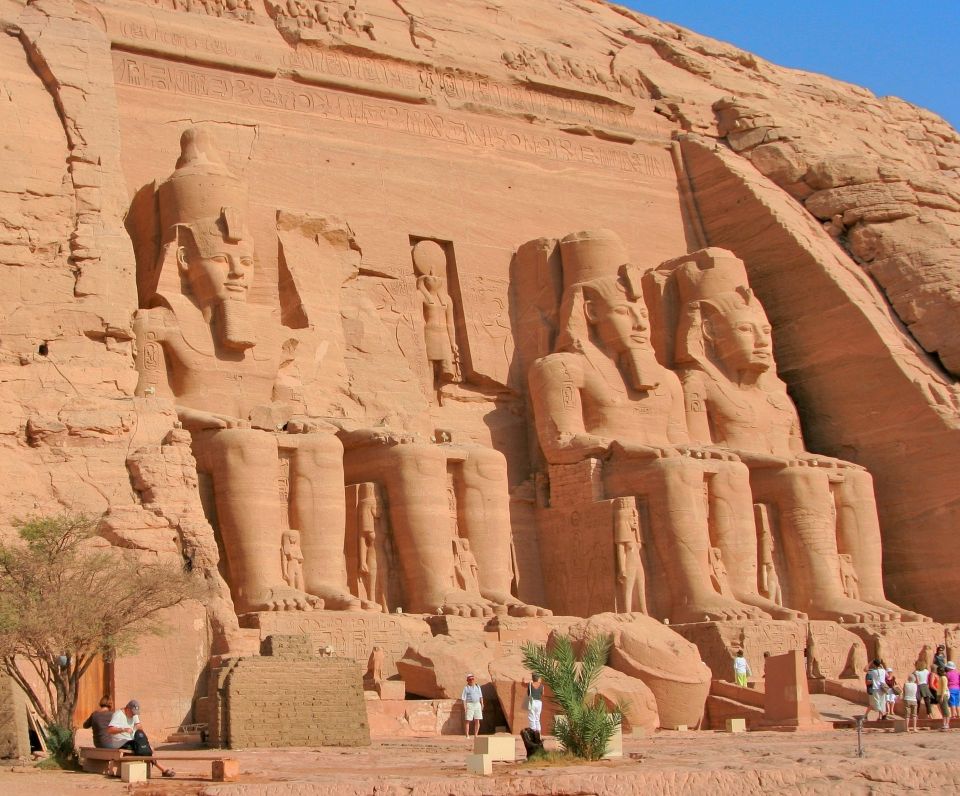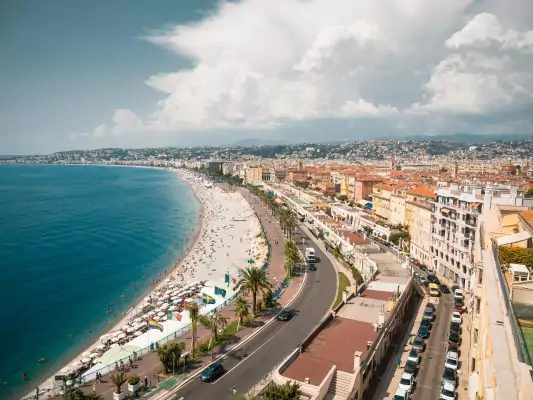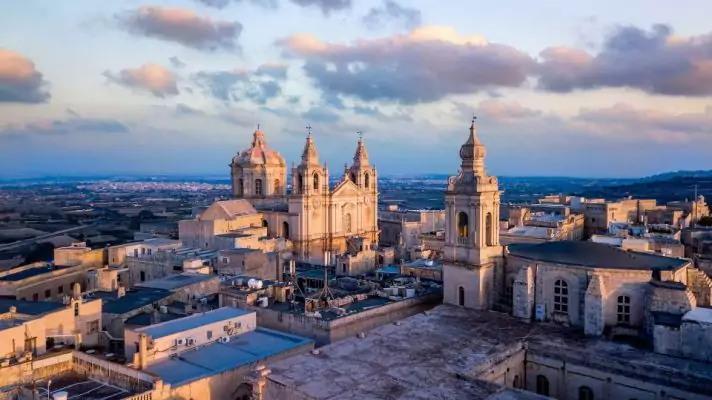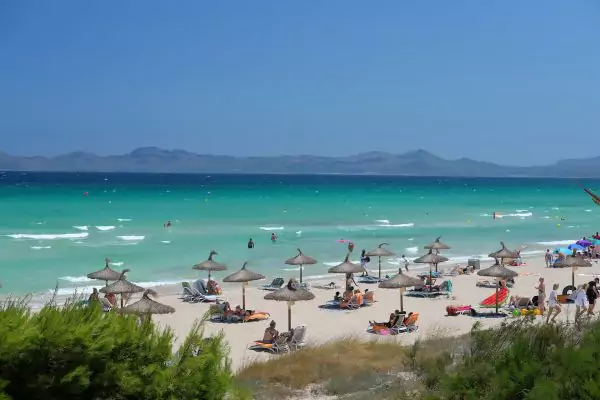Egypt 10-day Itinerary – What to see and do in the country

Best things to see and do in Egypt in 10 days, including a step-by-step route across the cities of Cairo, Hurghada, Luxor, Aswan and Abu Simbel. Discover the country’s most famous landmarks and tourist hotspots in our Egypt 10-day itinerary!
This Egypt 14-day itinerary is a part of our broader Egypt travel guide. We recommend you check it out for the best travel tips and the most accurate information on transportation, hotels, restaurants and scams in Egypt.
Egypt 10-day Itinerary – What to see and do in the country
Being one of the greatest tourist destinations in the world, and certainly the most popular across the African continent and the Middle East, there is certainly no shortage of amazing this to see and do in Egypt.
Although the more time the merrier, with 10 days you can skim through the country’s most famous landmarks, visiting the world-famous Pyramids, the iconic Valley of the Kings in Luxor and even the picturesque city of Aswan, while still having a couple of days off to enjoy the idyllic coast of the Red Sea. Though not the most extensive plan, 10 days in Egypt are still a good enough sample to experience the absolute best the country has to offer.
Be that as it may, if you’d like to stay longer, or happen to have even less available time in your hands, you can have a look at our other Egypt itineraries:
- Egypt 7-Day Itinerary – One week in the Land of the Pharaohs
- Egypt 14-day Itinerary – Best places to visit in 2 weeks
Without further ado, here is our Egypt 10-day itinerary!

Egypt 10-day itinerary: Day 1 – Cairo: The Downtown
Since you’ll be flying into the country, your first day in Egypt will necessarily have to be shorter. After completing your check-in at the hotel and freshening up a bit, we recommend a walk through the city center, most commonly known as the Downtown.
Once a bohemian area and meeting point for the British and French colonial elites, no other area of Cairo screams “decaying beauty” quite like the Downtown. There’s just something about its streets and Parisian-like façades that clearly shows the quarter’s best and most glorious days are way past behind it. And yet, the Downtown still somehow retains its inexplicable charm. Since you won’t have much time today, we recommend wandering aimlessly, trying some of the street food and slowly getting accustomed to Cairo’s very particular atmosphere. This a rough city, far from being unanimous among travelers. However, if you allow yourself to be absorbed into its controlled chaos, I promise you the rewards will be oh-so gratifying.

Take a walk around Tahrir Square, the spiritual heart of the city and epicenter of the 2011 Revolution, and, if you still have time, visit the Egyptian Museum (200 EGP). Since a brand-new museum is finally scheduled to be inaugurated this year at the Giza complex, the old institution is now emptier and far less resplendent than it used to, losing its previous status as a “must-see” in Cairo. Still, if you make it in time to fit the museum into your itinerary, it is still very much worth a visit.
Recommended tours (if you arrive in Cairo early in the day):

Egypt 10-day itinerary: Day 2 – Cairo: One of the 7 Ancient Wonders of the World
Now that you’re about to have your first actual full day in Egypt, it’s time to cross off your bucket-list the place you are most probably the most eager to visit in Cairo: the Giza Pyramids!

Considered the oldest of the 7 Ancient Wonders of the World, and funny enough the only one to resist the test of time, the Giza Pyramids (240 EGP to access the complex) are a true conundrum of architecture/engineering, having been built about 4500 years ago. Once inside the precinct, it is possible to enter the Khufu Pyramid (400 EGP) – colloquially known as the Great Pyramid – as well as its two smaller sisters, the Khafre and Menakure Pyramids (100 EGP to enter both). Plus, the general ticket also includes access to the royal tombs, the Eastern and Western Cemeteries, and, of course, the world-famous Great Sphinx of Giza. As mentioned above, the new Grand Egyptian Museum (GEM) will also be located inside the complex after its inauguration, somewhere in 2023. As an extra tip, and before returning to Cairo, make sure to check one of the most coveted views of the pyramids… which happens to be located inside an unsuspicious PizzaHut! A million-dollar view for a couple bucks worth of pizza.
After making it back to the big city, we recommend visiting the Saladin Citadel (200 EGP), a medieval Islamic fortress where you’ll find the Muhammad Ali Mosque, the most beautiful in all of Cairo, the Al-Gawhara Palace or the Egyptian Military Museum. To make things even better, the views over the city center are beyond gorgeous. On a clear day, you may even be able to spot the silhouette of the Pyramids in the horizon.

Finally, and because traveling is about a lot more than looking at pretty things, we suggest visiting the quarter of Manshiyat Nasser, located right next to the Citadel. However, I advert that this experience might not be for the faint of heart of weak of stomach. Also known as the “Trash Town”, this district is mostly inhabited by Coptic Christians and is well-known as the place where most of the trash of a 10-million people city ends up in. Since Cairo doesn’t really have a centralized system of waste treatment and management, this task has been taken up by the population of Manshiyat Nasser decades ago, as pretty much everyone is somehow connected to the sector. The end result is downright suffocating, and probably one of the greatest cultural-shocks you’ll ever experience while traveling.
Recommended tours:
- Full-Day Tour of the Giza Pyramids, Memphis and Saqqara
- Private tour of the Giza Pyramids with Camel Ride and Lunch

Egypt 10-day itinerary: Day 3 – Cairo: The Islamic Quarter
Considering this will be your final day in Cairo, a city where you could easily spend 5 or 6 days without running out of new places to see, it is time to go on a real journey down its true, magnetic essence. But both in travel and anatomy, you cannot reach the heart without fighting your way through the guts, which in the case of the Egyptian capital, can only mean a visit to the Islamic Cairo, a quarter this is just as beautiful and mesmerizing as it is daunting and exhausting. On a personal note, I am a big-time fan of Cairo… but I can understand exactly why so many people dislike it! If after your first two days you still can’t tell which side of the fence you sit on, then the Islamic Cairo is where you’ll pass your sentence.

Start your route at the Ibn-Tulun Mosque, the biggest in Egypt and one of the oldest in the African continent, before moving on to the Mosque-Madrasa Sultan Hassan (80 EGP), a beautiful complex made up of two religious buildings which stands to this day as one of the greatest examples of mamluk architecture in the city. On your way to the next tourist attraction, get lost inside the maze of narrow streets and alleyways that make up most of this ancient quarter, where the older gentlemen still sit on the doorstep talking about their lives while the kids spend their days kicking and running around an old rag ball.
After reaching the old Fatimid city walls, you must climb the Bab Zuweila (40 EGP), the city’s old western gate, where you’ll be surprised with an atmospheric view of the domes and minarets that populate much of the Old Cairo. From this point onward, you are officially entering the Khan el Khalili, the apparently endless city bazaar that occupies an enormous section of the old city. While walking through the insanely busy streets of the bazaar, make sure to do a small detour to visit the Al-Azhar Mosque and walk along the Al-Muizz li-Din Allah Street, an ancient road lined with classical buildings from the Mamluk Era.

At nightfall, make your way to Cairo’s Bus Station and prepare a few snacks and comfy clothes for the long night ahead of you. You’ll be waking up in a different city tomorrow.
Recommended tours:

Egypt 10-day itinerary: Day 4 – Luxor: The East Bank Temples
After a long 10-hour trip, you will finally arrive in Luxor quite early in the morning. Although the night wasn’t probably the most comfortable, at least you’ll have a full day to explore part of the city on a calmer, more relaxed pace.

Therefore, you should explore the East Bank of the city, starting with the spectacular Karnak Temple (220 EGP), one of the most impressive sites in all of Luxor. Despite its singular noun, the “Temple” is actually a complex resembling an open-air museum and made up of 4 temple ruins, obelisks, sacred lakes and statues. Definitely the highlight of the East Bank.
Afterwards, walk along the Avenue of Sphinxes until you reach the Luxor Temple (180 EGP), the second most popular and visited temple on this side of the river. According to legend, this is where Pharaohs used to be crowned in Ancient Egypt! Within the complex you will also find the Abu Haggag Mosque, a building with adobe details perfectly integrated into the ancient temple’s structure. Finally, take a leisurely walk through the small but lively Souq of Luxor.

Important detail: so that you can adequately prepare your following day at the West Bank, don’t forget to make your transportation arrangements. Start by asking at your place of accommodation whether they know any reliable cab driver or tour agency to help you move around in between the tombs and temples of the opposite bank. If you’re not happy about the price, you may simply approach a few drivers directly on the street and ask how much they would charge to drive you around the sites you wish to visit. Based on the West Bank attractions that will be mentioned on this 10-day Egypt itinerary, a fair price would be around 10-15€/car for the whole day.
Recommended tours:

Egypt 10-day itinerary: Day 5 – Luxor: Valley of the Kings and the West Bank
If you want to make sure you get to visit all the places mentioned throughout this day, then you better get out of bed early in the morning! The West Bank of Luxor has an absurd number of places to visit and they’re all relatively distant from one another (or at least too far to walk between them).

We’ll kick things off at the Valley of the Kings (260 EGP), the most sought-after site in all of Luxor and probably the second greatest tourist attraction in the whole country, right after the Pyramids of Giza. The Valley of the Kings is an excavated complex of tombs where – as you can assume from its name – Egyptian rulers used to be buried. Here, each tomb has its own chambers, size and artistic decoration, making every single piece a unique work of mortuary art. The admission ticket grants you access to three tombs of your choice, with the exception of the Tomb of Tutankhamun (300 EGP), the Tomb of Seti I (1000 EGP) and the Tomb of Ramses V and VI (100 EGP), which have to be paid separately. Out of a dozen of open tombs at your choice, we recommend picking 3 out of these 5 options:
- Tomb of Tuthmosis III
- Tomb of Ramses IV
- Tomb of Tausert & Setnakht
- Tomb of Ramses III
- Tomb of Merenptah
After visiting the Valley of the Kings, you’ll get back in the car and follow that up with the Temple of Hatshepsut (160 EGP). Still built during the lifetime of one of the most powerful Pharaohs in history (and a Woman, no less) to later serve as her mausoleum, this huge temple is considered a marvel of ancient architecture. Right next, a trip to the Valley of the Nobles is in order. A precinct where you can find over 400 tombs belonging to high-status citizens and courtiers of the pharaohs, each ticket allows you to visit a pre-determined set of 2 tombs. We recommend choosing the Tomb of Rekhmire and the Tomb of Sennefer (40 EGP to visit both), two of the most important and best preserved in the complex.

Up next, we suggest visiting Deir el-Medina (100 EGP), the ruins of an ancient city where the craftsmen who had to build the tombs at Valley of the Kings used to live. Besides some other tombs, the site is worth a visit due to the picturesque scenery of the ruins and the beautiful Hathor Temple, one of the very few places where it’s still possible to escape the crowds. To cap off your long day at the West Bank, visit the Medinet Habu Temple (100 EGP), probably the most underrated in Luxor. On your way back to the shores of the Nile, stop by the Colossi of Memnon for a quick photo op.
Recommended tours:

Egypt 10-day itinerary: Day 6 – Aswan: Elephantine Island and the Philae Temple
Rise and shine – it’s time to make it to Aswan! Since you’ll be traveling aboard an Egyptian train and the trip might take about 3-4 hours, you will not have the full day to explore this new city. Still, as soon as you make it to Aswan and drop your things off at the hotel, walk along the picturesque Aswan Corniche until you reach the public quay, where a ferry will take you to the Elephantine Island, the city’s most prominent symbol. No matter how much people try to convince you otherwise, rest assured there is indeed a public terminal where the trip costs 5 EGP. While visiting, you’ll have what is probably your first direct contact with Nubian culture and architecture, so prepare to be amazed by their bright colored façades! While you’re at it, visit the archaeological remains of the Ruins of Ancient Abu (100 EGP), which include the Temple of Khnum, as well as one of Aswan’s original Nilometers, the structures which allowed the natives to measure the water level during floods.

Before the day comes to an end, you’ll still have time to visit the Philae Temple (180 EGP), the most romantic in Egypt. Unfortunately, getting there is a true test to one’s patience! First of all, and because there is virtually no public transportation in that area, you’re going to have to negotiate a taxi or a tuk-tuk than can take you to the ticket office, wait for you while you visit the temple, and then bring you back to the city. A fair deal must be around 200 EGP per vehicle. This is where I drop a bit of a bomb: the temple is located on an island; and while the ticket technically includes the boat trip from the office quay to the island, I guarantee no one will take you there without you having to drop a pretty penny from your pocket! To make matters worse, you are completely at the mercy of the “boat mafia”. Since you’ve already made your way there and bought the ticket, they know very well you’re too invested to turn back now. Though their bid will surely start much higher, expect to settle at around 200-300 EGP per boat for a return-trip.

Still, there is no denying how awesome this temple is. The ruins are majestic, and because of its relative isolation, the atmosphere is also pretty calmer than most other temples in the region. It’s almost enough to make you forget how frustrating it was to get there!
Recommended tours:

Egypt 10-day itinerary: Day 7 – Aswan: Day Trip to Abu Simbel
As conflicting as this may sound, your second and final day in Aswan will be spent… outside Aswan! Book a tour in advance online or through a trusted contact of your place of accommodation and do not miss the chance of visiting the Temples of Abu Simbel (240 EGP)! As an alternative, there is a bus that leaves Aswan’s Bus Station every day at 08h00, arriving in Aswan at 11h00. The return trip leaves from Abu Simbel at 13h00, which, if we account for the time it takes to go from the local station to the temples, will leave you with just a little over an hour to explore the site.

Still, and regardless of your chosen option, the Temples of Abu Simbel are an absolute must for anyone visiting Egypt! The image of those giant pharaoh stone statues sitting at the entrance of the temple have almost become synonymous with the nation, further cementing its importance and symbolism. Curiously, and though the temples you’ll be visiting today are indeed original, their location is not. After the Egyptian authorities decided to move forward with the construction of the Aswan High Dam in the 1960s, the resulting floods across the region jeopardized many historical monuments. An endangered list which Abu Simbel was a part of. As a result, the temples were completely dismantled and later assembled at their current location, where scientists knew would be safe and sound from the rising water levels caused by the new dam.

Once you return to Aswan, hop on another public ferry, this time to the city’s less explored West Bank. That’s where you’ll find the Tombs of the Nobles (50 EGP), directly carved on the sides of a cliff. However, the tombs are far from being the main highlight. Considering the cliffs’ vantage point, this is the best place in the entire city to watch the sun setting over Aswan, the Elephantine Island and the calm waters of the Nile.
Recommended tours:

Egypt 10-day itinerary: Day 8 – The Trip from Aswan to Hurghada
Since there is not direct transportation between Aswan and Hurghada, the final destination on your Egypt 10-day itinerary, today will be spent getting from the former to the latter.
In order to do so, you’ll have to retrace your steps and hop on a train back to Luxor (3 to 4 hours). After making it to the city, it’s time to board a long-distance bus to Hurghada (another 4 hours). It will be a pretty tiring day, but once you make it to the Red Sea, there’s nothing but pure relaxation waiting you for the next couple of days.

Egypt 10-day itinerary: Day 9 – Hurghada: Rest and Recreation
After a well-rested night at the resort in Hurghada, your day will be spent doing absolutely nothing!
Just take the day off to rest your body after the stressful past few days, work on your tan and swim in the warm waters of the Red Sea.

Egypt 10-day itinerary: Day 10 – Hurghada: The Red Sea Corals
For the last day of your trip, and before returning to Cairo for your flight, take the morning to engage in what is the undisputed best activity one can try along the Red Sea coast: snorkeling!
Considering you won’t have much time to plan this activity beforehand, you’ll be better off booking your tour online or asking for contacts of local spotters at your hotel’s front desk. All tours usually include lunch, transportation and snorkeling equipment. You may also choose to scuba dive for an additional fee.
The Red Sea is world-famous for being the best place in the world to go snorkeling and watch the marine wildlife – and I can personally vouch for its reputation! Now it’s time for you to try it yourself.
Recommended tours:
Heymondo offers a wide range of travel assistance insurance policies. They combine the best quality, service and price with various levels of coverage, so you’re covered on your weekend getaways and long trips. Buy insurance »











